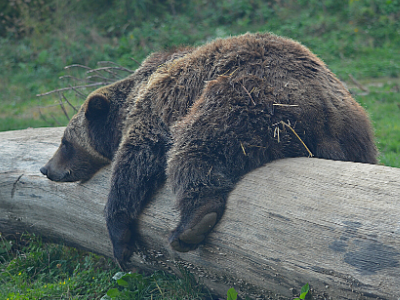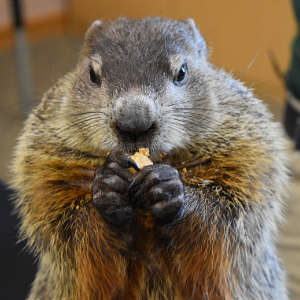In Ohio, we are lucky enough to experience every season. Winter, spring, summer and fall; there are people here who love them all! However, winter weather is something many of us forget to plan for. That is why November 15 - 21 is Winter Weather Preparedness Week in Ohio! For many of us, this reminds us to confirm we have a shovel in the garage and a scraper in the car, to stock up on salt, and to inspect our tire treads to ensure we will be safe on snowy roads. However, there are a few residents of Ohio who get ready a little differently: the animals at your Akron Zoo!
 Your Akron Zoo is home to animal residents from all over the world. Some of our animals are native to Ohio, so they are naturally inclined to prepare for winter. For example, Jackson and Cheyenne, our grizzly bears, begin to eat more and will eventually become less active as winter approaches. This may not come as a shock to you, since many of our guests expect our grizzly bears to be preparing for hibernation. However, like many species of bears, Jackson and Cheyenne actually spend the winter in a state of torpor instead of hibernation.
Your Akron Zoo is home to animal residents from all over the world. Some of our animals are native to Ohio, so they are naturally inclined to prepare for winter. For example, Jackson and Cheyenne, our grizzly bears, begin to eat more and will eventually become less active as winter approaches. This may not come as a shock to you, since many of our guests expect our grizzly bears to be preparing for hibernation. However, like many species of bears, Jackson and Cheyenne actually spend the winter in a state of torpor instead of hibernation.
“During torpor, bears do decrease the amount they are eating and increase their sleep, but there are also periods of time when they are awake and active,” says Stephanie Chandler, Behavioral Husbandry Manager. “That is why, in the fall, we increase the bears’ diet so they can build a healthy layer of fat. Then during the winter, when their activity and appetite decline, we lessen the amount we are feeding them. All of this is based on behavioral cues observed in our animals that let us know what they need.”
Other animals around the park also have natural defenses against the cold. Our wolves, coyotes and goats all have their own temperature barriers: their fur. All three of these species naturally grow thicker coats as the temperature outside drops, which helps to maintain their core temperature. Other animals, like our snow leopards and tahr, are native to cold, snowy environments, so they are already equipped for most of what an Ohio winter can dish out.
However, some of our species need a bit of help to prepare for the cold. This is where our keeping staff play a major role. In late fall, many habitats are equipped with additional temperature regulation features to keep our animals comfortable until spring, such as extra bedding, heat panels, and tarps that help to create wind barriers. The birds in our aviary, for example, have extra trees placed in their habitat, which offer a warm place to roost. Their habitat is also equipped with heating panels and an indoor space, which allows the birds to spend some time out of the elements. Others, like our waterfowl, are given higher calorie diets, so they can have more calories to burn to keep warm.
Even our animal ambassadors join in the hustle and bustle of the season!
 “Summer, our groundhog, starts gearing up for the seasonal change by the end of August or early September,” says Debra Swank, Training and Trends Coordinator. “Since she lives indoors, she doesn’t hibernate, but her metabolism still slows way down. Though her offered diet stays the same, her weight steadily increases, often by nearly a kilogram! By November, she becomes very difficult to get out of bed in the morning. When we check on her during opening rounds she will generally peek her nose out, then simply gather her hay/straw/paper bedding back around her - the equivalent of pulling the covers over your head when the alarm clock goes off. She also grows a really nice, thick undercoat, which Summer claims is why she ‘appears’ to look a bit heftier during the winter months. She still has periods of ‘groundhog crazies,’ they just lack the stamina of summertime.”
“Summer, our groundhog, starts gearing up for the seasonal change by the end of August or early September,” says Debra Swank, Training and Trends Coordinator. “Since she lives indoors, she doesn’t hibernate, but her metabolism still slows way down. Though her offered diet stays the same, her weight steadily increases, often by nearly a kilogram! By November, she becomes very difficult to get out of bed in the morning. When we check on her during opening rounds she will generally peek her nose out, then simply gather her hay/straw/paper bedding back around her - the equivalent of pulling the covers over your head when the alarm clock goes off. She also grows a really nice, thick undercoat, which Summer claims is why she ‘appears’ to look a bit heftier during the winter months. She still has periods of ‘groundhog crazies,’ they just lack the stamina of summertime.”
Some of our other animal ambassadors also experience seasonal changes. Many of our native birds, for example, live in outdoor yards where they can enjoy the seasons. Since they are exposed to the winter elements, we increase their diets starting in October or November. Like our waterfowl, the extra weight helps to insulate them and provides the energy needed to maintain their body temperature.
“We even see changes in some of our reptiles,” notes Debra. “Though they live in temperature controlled houses, many reptiles still experience seasonal cycles. Our big female Dumeril’s ground boas, who are both over 8 feet long and around 30 pounds, stop eating on their own accord around October. They stay in a state of brumation until February or March, or a state of dormancy for cold blooded animals, similar to hibernation.”
While you probably aren’t growing new fur or putting on the pounds, we hope you are getting ready for winter as well! Don’t forget to get started this week! Be sure to swing by the Akron Zoo, which is open year round! Our animals would love to see you. Thank you for your continued support.
